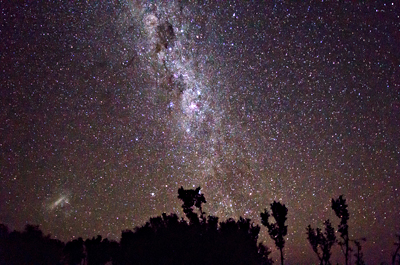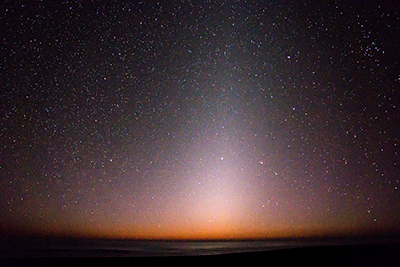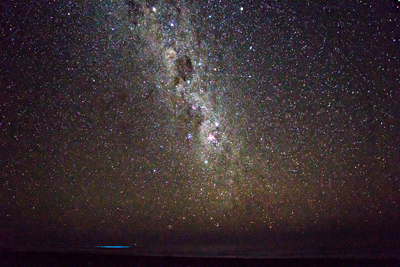
When
it turned out that I'd have a chance to accompany my sister and her son
on their trip from Johannesburg to Namibia and Botswana, I instantly
knew that one of the things I was going to try is astrophotography with
my new Ricoh GXR camera and its A16 (24-85mm)
unit. The A16 houses an APS-C sized CMOS sensor, so nighttime
timelapses of the southern sky with this camera/unit seemed feasible.
Initially I was hoping to take some of my nocturnal timelapses with a Quiver tree (Kokerboom) or Baobab tree in the foreground, but this was a naive expectation, because it would demand different planning of the trip. Moreover, the weather conditions were not favorable for part of the trip - very strong, cold wind and blowing dust did not allow timelapsing at all on several nights. Also, some of the camps we stayed at had their lights switched on for all of the night, thus disabling any astrophotography attempts. Despite all of these problems I managed to take several timelapse movies of the southern night sky, shown below. Though the foreground landscapes were not quite as exotic as I'd hoped, these nocturnal timelapses exceeded my expectations ...
The places from which the timelapse movies shown below were captured are indicated on this map. And here is a photo of my Ricoh GXR with its A16 unit, which did all the excellent job, shown below.
Initially I was hoping to take some of my nocturnal timelapses with a Quiver tree (Kokerboom) or Baobab tree in the foreground, but this was a naive expectation, because it would demand different planning of the trip. Moreover, the weather conditions were not favorable for part of the trip - very strong, cold wind and blowing dust did not allow timelapsing at all on several nights. Also, some of the camps we stayed at had their lights switched on for all of the night, thus disabling any astrophotography attempts. Despite all of these problems I managed to take several timelapse movies of the southern night sky, shown below. Though the foreground landscapes were not quite as exotic as I'd hoped, these nocturnal timelapses exceeded my expectations ...
The places from which the timelapse movies shown below were captured are indicated on this map. And here is a photo of my Ricoh GXR with its A16 unit, which did all the excellent job, shown below.

Ricoh GXR A16 (24-85mm), interval 35 seconds, speed 700x
Shutter speed 15 seconds, ISO 3200, 24mm, F/3.5
20120710_1730-2014utc_Crux-Bundu.mp4 (18 MB, 1080x720, H.264 / MPEG-4)
20120710_1730-2014utc_Crux-Bundu.mov (59 MB, 1080x720, H.264 / QuickTime)
Milky Way near the Crux (South Cross),
Carina (Keel) and Vela (Sails) constellations, from Bundu farm.
The Coalsack Dark Nebula can be seen at the top of these images, and
Large Magellanic Cloud at the bottom left. See also the still image for this case and its legend
(the same image with indicated constellations and other celestial
objects). This was my first timelapse attempt of the southern night
sky, under perfect conditions (clear and dark sky, no light pollution
around). It was captured from a farm of my sister's friend Bundu, Karoo
Region, Northern Cape Province, South Africa.
Technical details about capturing and processing of all of these cases are given further below. Here, I just want to stress that the results can't quite compete with similar timelapse movies shot with much more expensive professional or full-frame DSLR cameras and faster professional lens; however for a camera at total price of about 650 EUR (GXR and A16 unit) these are indeed very nice.
Technical details about capturing and processing of all of these cases are given further below. Here, I just want to stress that the results can't quite compete with similar timelapse movies shot with much more expensive professional or full-frame DSLR cameras and faster professional lens; however for a camera at total price of about 650 EUR (GXR and A16 unit) these are indeed very nice.

Ricoh GXR A16 (24-85mm), interval 35 seconds, speed 700x
Shutter speed 15 seconds, ISO 2500, 24mm, F/3.5
20120711_1713-1806utc_Zodiac_Augrabies.mp4 (9 MB, 1080x720, H.264 / MPEG-4)
20120711_1713-1806utc_Zodiac_Augrabies.mov (15 MB, 1080x720, H.264 / QuickTime)
Zodiacal light after sunset from Augrabies.
Zodiacal
light,
an illuminated disc of dust surrounding our Sun, visible either after
sunset or before sunrise, can be observed under dark sky even from
mid-latitudes. However, the closer to the Equator, the steeper its
inclination with respect to the horizon, and thus also the better its
visibility. This sequence was captured from
LAT = 28.6 S, from a campsite at Augrabies
Falls National Park, Northern Cape Province, South Africa, using
the same camera settings as all the remaining cases below.
See also one of the still images from this timelapse series, and a composite "startrails image" created from 25 still images of this sequence (taken between 17:21 and 17:36 UTC), using the Startrails Application software from Achim Schaller. In the startrails image the visibility of the Zodiacal light is enhanced (compared to a still image) thanks to the process by which this image product is assembled.
See also one of the still images from this timelapse series, and a composite "startrails image" created from 25 still images of this sequence (taken between 17:21 and 17:36 UTC), using the Startrails Application software from Achim Schaller. In the startrails image the visibility of the Zodiacal light is enhanced (compared to a still image) thanks to the process by which this image product is assembled.

Ricoh GXR A16 (24-85mm), interval 35 seconds, speed 700x
Shutter speed 15 seconds, ISO 2500, 24mm, F/3.5
20120711_1828-1916utc_MW_Sco-Sgr_Augrabies.mp4 (8 MB, 1080x720, H.264 / MPEG-4)
20120711_1828-1916utc_MW_Sco-Sgr_Augrabies.mov (21 MB, 1080x720, H.264 / QuickTime)
Central parts of the Milky Way, at Scorpius
(Scorpion) and Sagittarius (Archer) constellations.
My first attempt (and unfortunately also the last one) of capturing the
central region of our galaxy, the Milky Way. See also the still image for this case and its legend. Taken from a camp at Augrabies
Falls National Park, Northern Cape Province, South Africa.
Technical
details and comments .
All the images were captured into both, raw (DNG) and JPG formats. The
exposure was set to 15 seconds, followed by another
15 seconds for dark frame removal, and 5 seconds to record
the image data to SDHC memory card. The 15-second exposure, combined
with 24 mm (equivalent) lens, still results in almost point-like
images of stars, and at the same time providing sufficiently long
exposure to record the low-light details. The images used for these
timelapse movies were processed from the DNG files with Photoshop CS5. Here
you can download (as a sample to play with) the original DNG file, the
corresponding original JPG file (out of the camera image), the
full-size processed JPG file, and the XMP file with the settings I used
to process the DNG file in Photoshop CS5. As you will see, the original
JPG files are useless for these purposes; working with DNG files is
essential.

Ricoh GXR A16 (24-85mm), interval 35 seconds, speed 700x
Shutter speed 15 seconds, ISO 2500, 24mm, F/3.5
20120712_1915-2100utc_Crux_Ai-Ais.mp4 (13 MB, 1080x720, H.264 / MPEG-4)
20120712_1915-2100utc_Crux_Ai-Ais.mov (22 MB, 1080x720, H.264 / QuickTime)
Milky Way near the South Cross from Ai-Ais.
Similar part of the sky as shown in the first case;
see also the still image. Captured from a camp at Ai-Ais Hot
Springs, located at the Ai-Ais/Richtersveld
Transfrontier Park,
southern Namibia. The mountains across the Fish River are illuminated
by several lights at the resort, and the tree at the left is
occasionally lit by our campfire.
Due to bad weather (very strong and cold winds, with plenty of dust everywhere) I was not able to timelapse for several nights that followed. Therefore I missed the famous dark sky of the NamibRand Nature Reserve. The winds fortunately calmed down when we reached the Atlantic coast, and I could experiment with timelapsing again - see the next cases below.
Due to bad weather (very strong and cold winds, with plenty of dust everywhere) I was not able to timelapse for several nights that followed. Therefore I missed the famous dark sky of the NamibRand Nature Reserve. The winds fortunately calmed down when we reached the Atlantic coast, and I could experiment with timelapsing again - see the next cases below.

Ricoh GXR A16 (24-85mm), interval 35 seconds, speed 700x
Shutter speed 15 seconds, ISO 2500, 24mm, F/3.5
20120717_1747-1917utc_Zodiac_Mile108.mp4 (12 MB, 1080x720, H.264 / MPEG-4)
20120717_1747-1917utc_Zodiac_Mile108.mov (23 MB, 1080x720, H.264 / QuickTime)
Zodiacal light after sunset from Skeleton
Coast, Mile 108 camp.
Captured from the coast of the Atlantic Ocean, at
LAT = 21.4 S, from a campsite at Mile 108, Skeleton
Coast, Namibia. The impact of the lower geographical latitude is
obvious - when comparing the inclination of the Zodiacal light cone
with respect to the horizon for this case and the one above, this one
is noticeably more perpendicular to the horizon.
All the "traffic" in the sky, which can be seen not only in this timelapse movie, but in most of the other ones as well, are satellites on various orbits, and possibly also several meteors (meteors will appear in one image frame only, while most of the satellites can be followed in several consecutive image frames). At the end of this series you may also notice bluish patches of light at the sea level - a manifestation of bioluminescence (Sea Sparkle); for more on this impressive phenomenon see the next case below.
See also one of the still images of this series, and the startrails image (again created from 25 still images, taken between 18:00 and 18:15 UTC).
All the "traffic" in the sky, which can be seen not only in this timelapse movie, but in most of the other ones as well, are satellites on various orbits, and possibly also several meteors (meteors will appear in one image frame only, while most of the satellites can be followed in several consecutive image frames). At the end of this series you may also notice bluish patches of light at the sea level - a manifestation of bioluminescence (Sea Sparkle); for more on this impressive phenomenon see the next case below.
See also one of the still images of this series, and the startrails image (again created from 25 still images, taken between 18:00 and 18:15 UTC).

Ricoh GXR A16 (24-85mm), interval 35 seconds, speed 700x
Shutter speed 15 seconds, ISO 2500, 24mm, F/3.5
20120717_1921-2021utc_Crux_SeaSparkle_Mile108.mp4 (9 MB, 1080x720, H.264 / MPEG-4)
20120717_1921-2021utc_Crux_SeaSparkle_Mile108.mov (22 MB, 1080x720, H.264 / QuickTime)
Bioluminescence (Sea Sparkle) and Milky Way
from Skeleton Coast, Mile 108 Rest Camp. Besides
the impressive Milky Way setting into the Atlantic Ocean, the other
fascinating show was the Sea Sparkle.
Some of the breaking waves further away in the sea seemed to display a
faint silver glow, which in photos turned out to be distinct blue
(probably the brightness of the sparkle was too low for our eyes to
distinguish its color, which is normal for low-light vision of humans).
See also one of the still images, and the startrails image
- in this case created from the whole timelapse series, showing very
nicely not only the southern celestial pole, but also highlighting the
bluish Sea Sparkle. The yellow traveling dots on the sea horizon are
lights of distant ships. Unfortunately this series was terminated
sooner than I wanted, by dew condensing on the protective filter of my
camera lens.
For some other examples of the Sea Sparkle see this, this and this websites.
For some other examples of the Sea Sparkle see this, this and this websites.

Ricoh GXR A16 (24-85mm), interval 35 seconds, speed 700x
Shutter speed 15 seconds, ISO 2500, 24mm, F/3.5
20120718_1810-2030utc_Crux_Xaragu.mp4 (16 MB, 1080x720, H.264 / MPEG-4)
20120718_1810-2030utc_Crux_Xaragu.mov (36 MB, 1080x720, H.264 / QuickTime)
Milky Way near the South Cross and
Centaurus from Camp Xaragu.
Similar area of the sky as in several previous cases, taken probably
under the best conditions from the entire trip. See also the still
images - one from about the middle of the sequence (with the South Cross in
center of the image), and another one from its end (and the same image with constellations figures). The startrails image
created from the whole sequence shows very nicely the southern
celestial pole; the red color of the nearby hill results from our
campfire.
The night sky above Damaraland from Camp Xaragu was definitely the best one I have seen on our trip. If I just knew that this was going to be the last really deep-dark and crystal-clear night of our trip, I would have stayed up timelapsing the entire night there ... And here is the link to the Camp Xaragu.
The night sky above Damaraland from Camp Xaragu was definitely the best one I have seen on our trip. If I just knew that this was going to be the last really deep-dark and crystal-clear night of our trip, I would have stayed up timelapsing the entire night there ... And here is the link to the Camp Xaragu.

The
nights which followed (at Etosha, and on our way back to Johannesburg)
were not nearly as clear as some of the previous nights - the sky had a
rather "muddy" appearance, not being that attractive for timelapsing.
So here is at least one sunset from Kalahari Rest Camp on the
Trans-Kalahari Highway in Botswana where we stayed at for two nights,
and an image
taken at dawn of our last day of the trip. It shows the rising Orion
constellation (from our European perspective being upside-down), Venus
and Jupiter. This was my farewell photo with the dark sky of southern
Africa ...